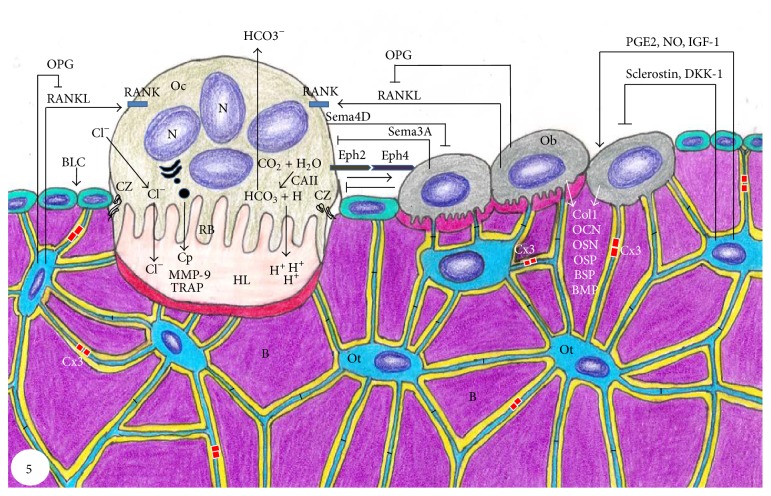Figure 5.
Schematic summary of bone tissue showing bone cells and the relationships among them and with bone matrix (B). Osteoclast (Oc) activation occurs after binding of RANKL to its receptor RANK, present in the membrane of osteoclast precursors. Then, osteoclast becomes polarized through its cytoskeleton reorganization; the ruffled border (RB) and clear zone (CZ) are membrane specializations observed in the portion of the osteoclast juxtaposed to the bone resorption surface, Howship lacuna (HL). Dissolution of hydroxyapatite occurs in the bone surface adjacent to the ruffled border (RF) upon its acidification due to pumping of hydrogen ions (H+) to the HL. H+ and ions bicarbonate (HCO3 −) originate from the cleavage of carbonic acid (H2CO3) under the action of carbonic anhydrase II (CAII). After dissolution of mineral phase, osteoclast (Oc) releases cathepsin (Cp), matrix metalloproteinase-9 (MMP-9), and tartrate-resistant acid phosphatase (TRAP) that degrade the organic matrix. EphrinB2 (Eph2) present in osteoclast membrane binds to ephrinB4 (Eph4) in osteoblast (Ob) membrane, promoting its differentiation, whereas the reverse signaling (ephrinB4/ephrinB2) inhibits osteoclastogenesis. Sema4D produced by osteoclasts inhibits osteoblasts, while Sema3A secreted by osteoblasts inhibits osteoclasts. Osteoblasts (Ob) also produce receptor activator of nuclear factor KB (RANKL) and osteoprotegerin (OPG), which increase and decrease osteoclastogenesis, respectively. Osteoblasts (Ob) secrete collagenous (Col1) and noncollagenous proteins such as osteocalcin (OCN), osteopontin (OSP), osteonectin (OSN), bone sialoprotein (BSP), and bone morphogenetic proteins (BMP). Osteocytes (Ot) are located within lacunae surrounded by mineralized bone matrix (B). Its cytoplasmic processes cross canaliculi to make connection with other neighboring osteocytes processes by gap junctions, mainly composed by connexin 43 (Cx3), as well as to cytoplasmic processes of osteoblasts (Ob) and bone lining cells (BLC) on bone surface. RANKL secreted by osteocytes stimulates osteoclastogenesis, while prostaglandin E2 (PGE2), nitric oxide (NO), and insulin-like growth factor (IGF) stimulate osteoblast activity. Conversely, osteocytes produce OPG that inhibits osteoclastogenesis; moreover, osteocytes produce sclerostin and dickkopf WNT signaling pathway inhibitor (DKK-1) that decrease osteoblast activity.

